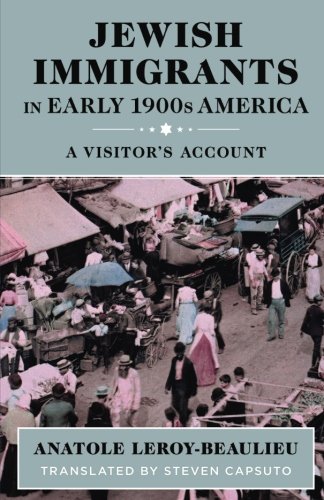
"Jewish Immigrants in Early 1900s America: A Visitor's Account" by Anatole Leroy-Beaulieu, translated by Steven Capsuto - Paperback, 110 pp. | Ebook
A photo-illustrated booklet celebrating Jewish immigrant life in America
From the 1880s to 1920s, more than 2 million Jews immigrated to the United States. Most were fleeing poverty and persecution in Eastern Europe and the Russian Empire. As their numbers swelled, Jews in America built new identities and strong communities.
At the height of that migration, this French writer, a scholar of anti-Semitism, toured the eastern US to see how the refugees were doing. “I had already visited most of the Jewish quarters in Europe, Asia and Africa,” he explained. Now he wanted to explore the crowded, bustling Jewish neighborhoods of America. What he saw amazed him.
A PHOTO-ILLUSTRATED BOOKLET CELEBRATING JEWISH IMMIGRANT LIFE IN AMERICA
From the 1880s to 1920s, more than 2 million Jews immigrated to the United States. Most were fleeing poverty and persecution in Eastern Europe and the Russian Empire. As the U.S. Jewish population swelled from 250,000 to 4 million, Jews in America built new identities and strong communities for themselves.
At the height of that migration, French political writer Anatole Leroy-Beaulieu (author of “Israel among the Nations,” a then-famous book about anti-Semitism) toured the eastern U.S. to see how the refugees were doing. “I had already visited most of the Jewish quarters in Europe, Asia and Africa,” he explained. Now he wanted to explore the crowded, bustling Jewish neighborhoods of America. What he saw amazed and impressed him.
That autumn, he gave an enthusiastic, insightful talk to the Jewish Studies Association in Paris, telling what he had seen and praising a “land of wonders and liberty” where long-oppressed Jews were now thriving. Librairie Nouvelle published his lecture as a booklet in 1905. This new English translation contains more than fifty vintage photographs and illustrations.
ABOUT THE AUTHOR:
Anatole Leroy-Beaulieu (1842–1912) was a French political scientist and historian who wrote extensively about Russia, anti-Semitism, the role of religion in politics, and political movements in Europe. English translations of three of his books appeared from 1892 to 1900: Israel among the Nations: A Study of the Jews and Antisemitism, The Empire of the Tsars and the Russians, and Papacy, Socialism and Democracy. His prolific contributions to the magazine La Revue des Deux-Mondes included some essays about Jews and anti-Semitism. Leroy-Beaulieu was a professor of political science at the École Libre des Sciences Politiques in Paris from 1880 to 1912, and became the president of that college in 1906. A member of the French Institute and the French Academy of Moral and Political Science, he also served as president of the Society for Social Studies and as the final president of the French Anti-Atheist League.
His optimism about people’s ability to coexist peacefully is seen in his active involvement in the 1900 World’s Fair in Paris—an event that symbolized global friendship and cooperation—and his service on the board of an international arbitration organization. In 1901, in one of his more presciently optimistic projects, he led a committee of political scholars who urged the formation of a “European union” that they proposed calling “the United States of Europe.” Like certain thinkers in previous centuries, they considered this the best hope for peace and prosperity on that continent. Leroy-Beaulieu himself wrote the committee’s detailed proposal on how such a union might work, published more than nine decades before the founding of the European Union and half a century before its earliest predecessor.




